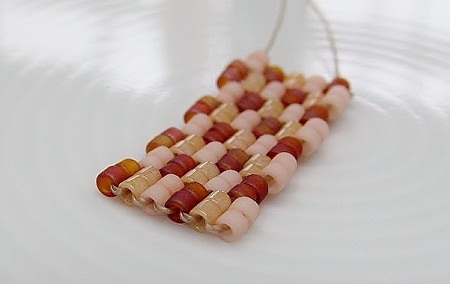When you stitch a rather large piece, you may want to work faster and use the flat two-drop even-count peyote, which is a variation on the basic even-count stitch. The two-drop will also change the look of the pattern and a diagonal line in a motif will turn out more abrupt.
Although you could use seed beads for the peyote stitch it is recommended to use Delica (Miyuki), as the perfect tubular shape of this particular bead will make it easier to gain insight in the thread path.
Challenge:
- Gaining insight into the thread path in order to get used to flat two-drop even-count peyote stitch.
Supplies for a sample :
- Delica 11/0 beads in three colors
- S-lon thread D
- John James needles no. 12
- scissors and a beading surface
Weaving instructions for a sample in two-drop even-count flat peyote
- take a comfortable length of thread, about 1,5 meter
- leave a long tail end, about 15 to 20 cm
- add on a bead in a different color and go twice through it in order to fix the bead, this one will function as your stop bead and is removed later on
- as both the first and second row need to have an even number of pairs, the total number of beads needs to be dividable by 4
- or in other words, pick up a number of beads forming a multiple of 4
- in our sample, we used 16 Delica in two alternating colors in order to form 4 pair of beads for the 1st row and 4 pair for the 2nd row
- to make the U-turn and weave the 3rd row, pick up 2 beads in the 3rd color, skip the previous 2 you picked up and slide your needle through the next 2 beads
- a section is made by picking up 2 new beads, skipping 2 beads and stringing 2 beads
- with each section 2 beads drop a half-height
- continue till the end of the row, to where your needle exits the very first two beads you strung
- which means, the tail thread and the work thread meet each other at the end of row 3
SEE - part 2







